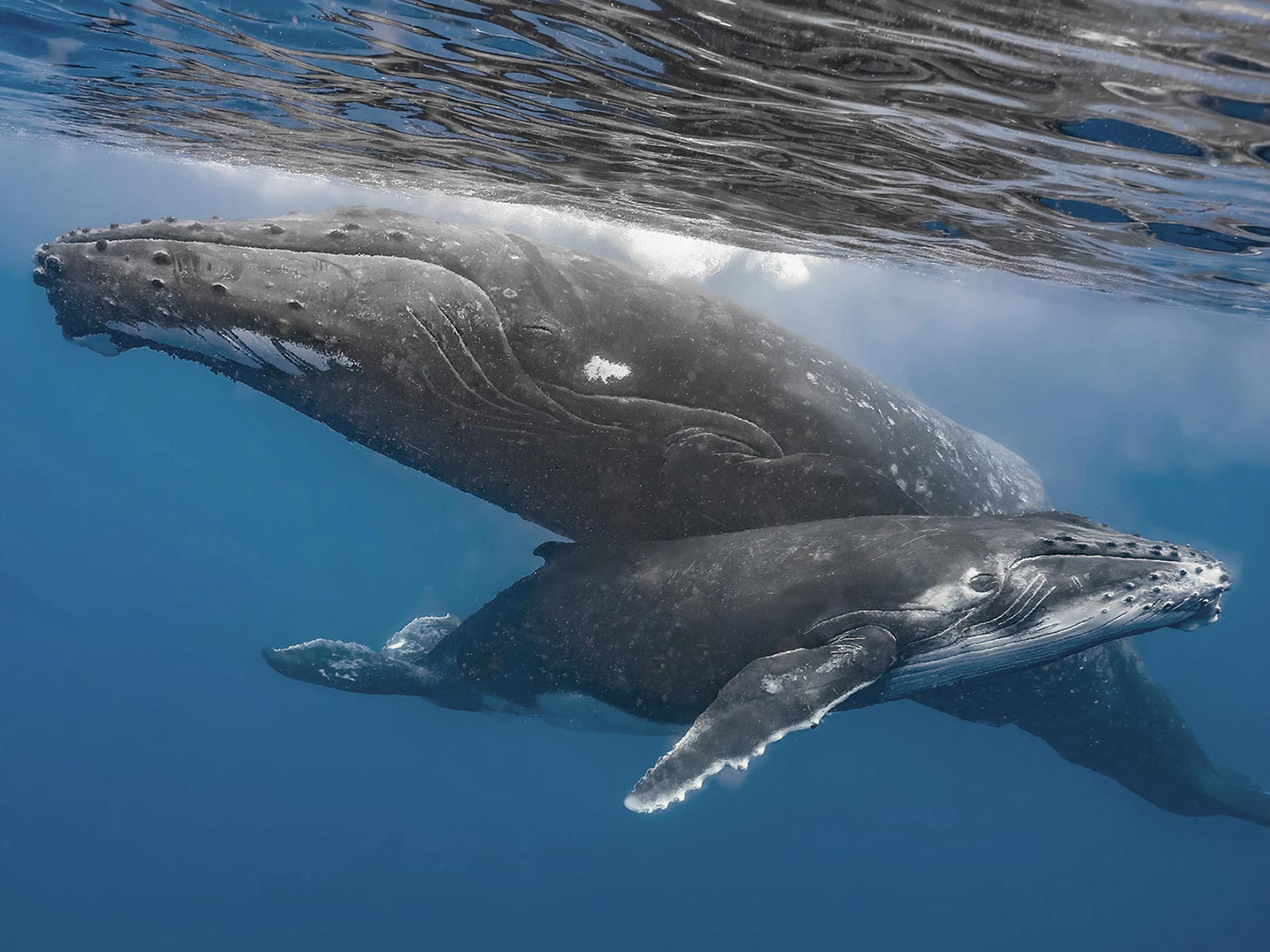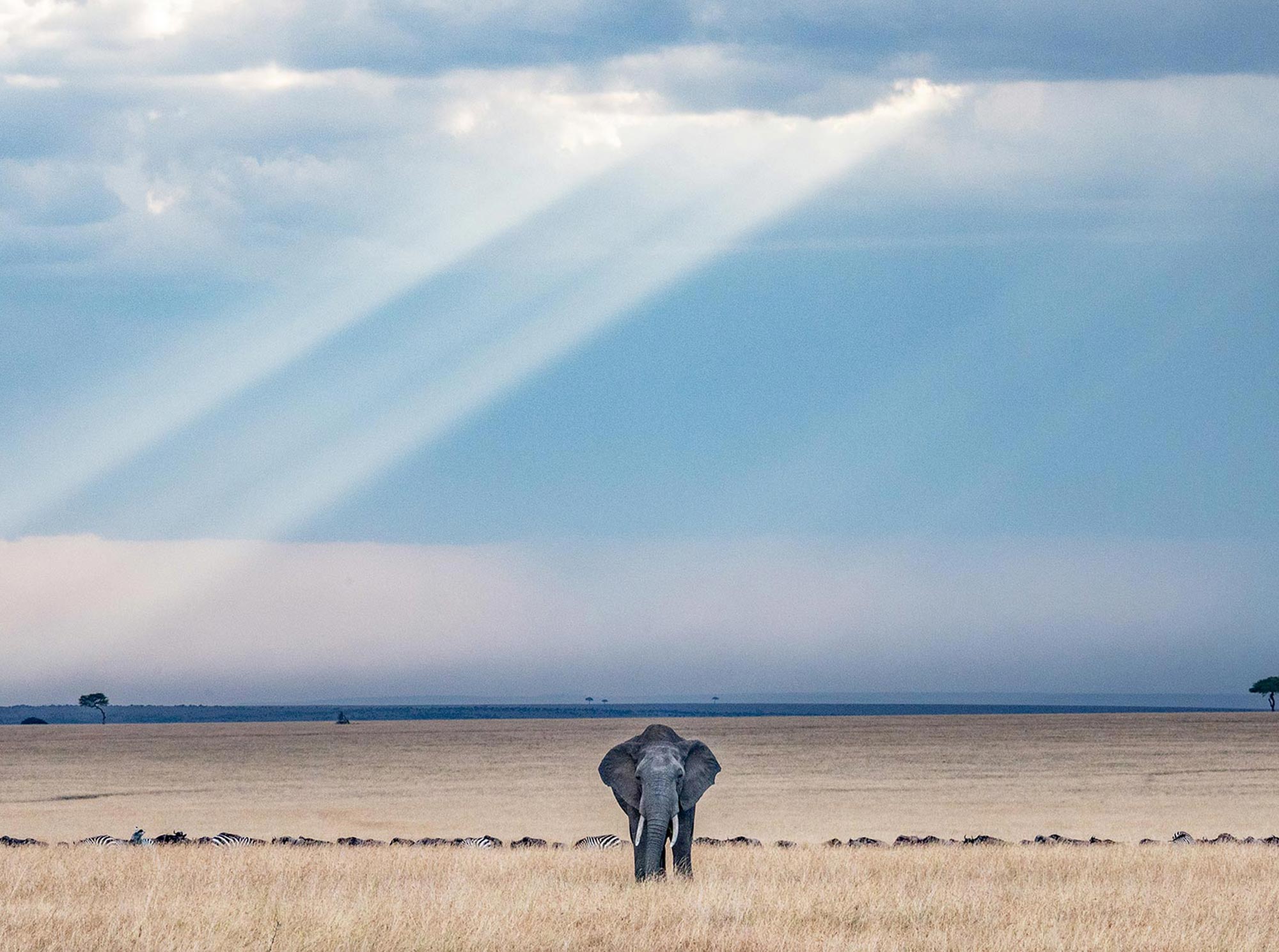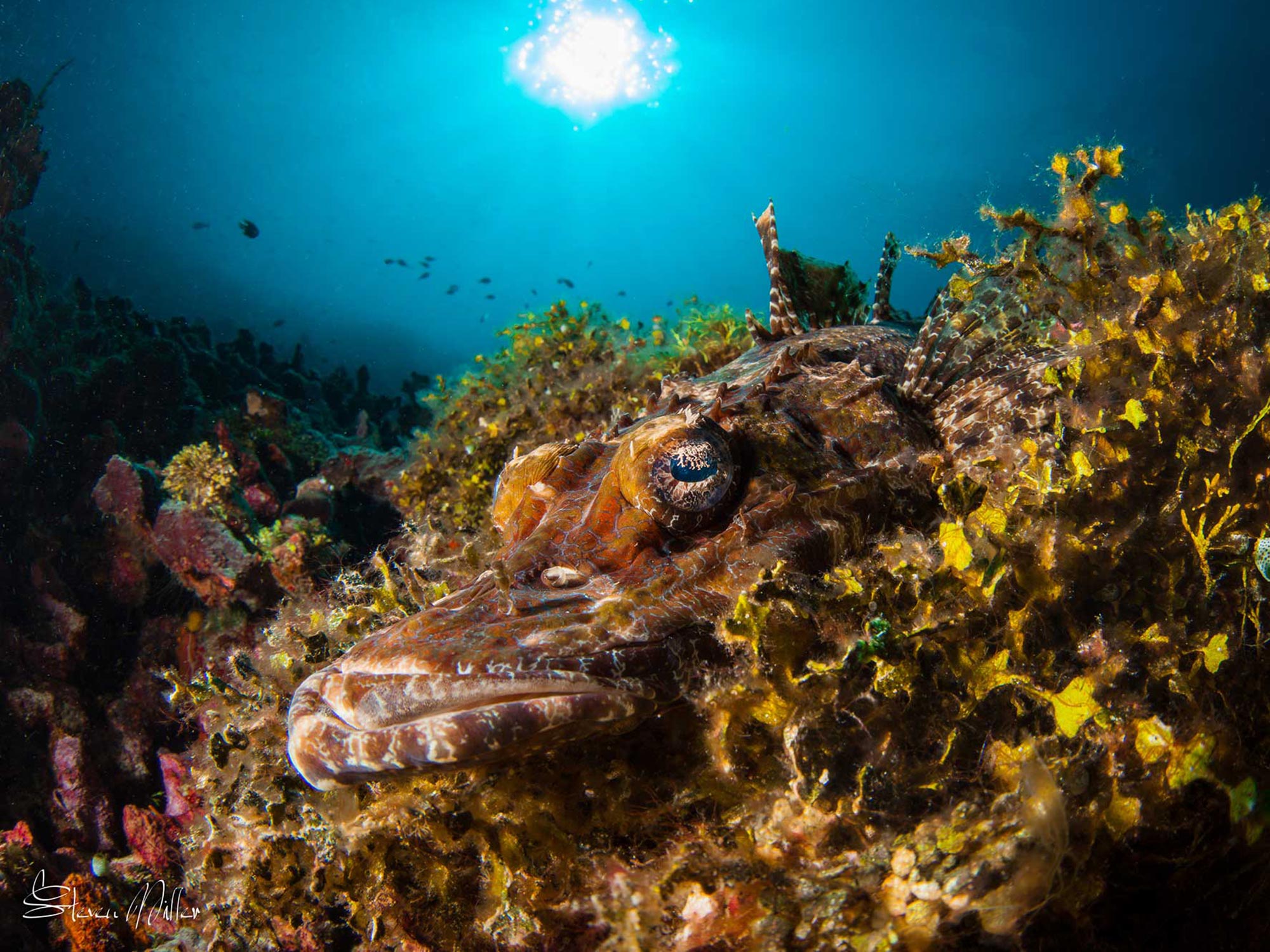By Glenn Ostle
In late September my partner, Pam Hadfield, and I joined a group of photographers to snorkel with and photograph Humpback Whales in Moorea, a picturesque island in French Polynesia just a short ferry ride from Tahiti.
August through early November is Humpback season. After an incredible 6,000 kilometer journey from Antarctica, the whales arrive in these rich, warm waters to mate and give birth to their calves.

A large Humpback Whale breaches close to a small boat. This behavior happens infrequently and unexpectedly. I spent a lot of time on our boat, with my “surface” camera on my lap, waiting for something like this to happen. 1/1000 • f/8 • ISO 280 © 2021 Glenn Ostle
For this trip I took along two Nikon Z6 mirrorless cameras and a selection of mid- to wide-angle lenses: one camera for underwater shooting in my Ikelite 200DL housing, and the second, with a 28-300mm telephoto lens, for above water shots. Other photographers on the boat were equipped with a wide range of cameras from small compact setups to large dome housings.

This curious calf came in for a close look. As it was close to the surface on a very sunny day, getting the colors correct was much easier than if the whale was deeper. 1/200 • f/8 • ISO 500 © 2021 Glenn Ostle
Swimming with Whales
Despite their size, Humpback Whales are some of the most gentle animals in the world and swimming with them is safe as long as you are respectful of them, follow directions, and understand that encounters must take place on their terms and under the guidance of a licensed captain and guide(s).

I like to get people in pictures with animals because it helps tell the story. It provides a nice size comparison and helps the viewer relate to what the photographer is doing. Once again, black and white adds a dramatic look. 1/200 • f/8 • ISO 560 © 2021 Glenn Ostle
French Polynesia has been a sanctuary for whales and dolphins since 2002 and strict laws dictate how interactions must occur. For instance, the boat cannot approach whales closer than 300’ (and at least twice that distance if the mother has a calf), which means a long swim to the whales. Also, snorkelers must stay in their group and with their guide, and no freediving, chasing or swimming after the whales is allowed.

It is exciting to be in the water with whales, especially when they come close to the surface. But strict rules in French Polynesia, govern an encounter with them. 1/200 • f/8 • ISO 450 © 2021 Glenn Ostle
Snorkelers are warned not to get too close to the whales and instead must wait for the animals to approach them. The guides are constantly watching for whales coming up from the deep and advising snorkelers if they are too close. If calves are present, you must wait to see if the mother will tolerate the nearby presence of people.

This photo of a juvenile Humpback Whale looks good in color as the water was very clear near the surface. But converting it to black and white I believe makes it almost jump off the page. Notice in the lower left portion you can see a distant image of the calf’s mother. 1/200 • f/8 • ISO 1000 © 2021 Glenn Ostle
This may sound easy but 300’ or more is a long way to kick while pushing large cameras through rolling seas. Often when we arrived where the whales were supposed to be, they had dived or moved on. Then we would swim back to the boat and try again. One day we repeated the process four or five times before we finally found a whale that would allow our approach.

The whale calf is about 15’ long and like all juveniles is curious about its surroundings. It is not unusual for a calf to frolic on the surface and even swim quite close to snorkelers in the water. 1/200 • f/8 • ISO 320 © 2021 Glenn Ostle
Another factor was the number of people on site. Once a whale or whale and calf family was sighted, a number of local whale watching boats would rush to the area and it wasn’t unusual to have three or four boats putting snorkelers in the water at the same time. While we only had twelve people on our boat, by the time we were observing a whale there were sometimes as many as 40-50 people bobbing around in 1000’ of water, trying to get a glimpse or a picture.
That said, it is a big ocean and the guides worked hard to keep people in their own groups. Also, many operations were only out for the morning while we had a private boat and stayed out all day.

This is another photo that benefits from conversion to black and white. Again, the light beams radiating upwards frames the whale nicely. 1/200 • f/8 • ISO 500 © 2021 Glenn Ostle
Working from our large 31’ zodiac, our encounters with the whales varied. Some days we found very few and spent a lot of time on the boat. At times the captain would drop a hydrophone into the water which allowed us to hear whales singing, which was a real treat. We could sometimes also hear - and feel - their songs while we were in the water.
When we did have an encounter, the whales were often far away resulting in pictures being very blue. At other times, the whales came quite close including several with a calf. While the mother dozed down deep, the curious calf would often frolic quite close to the snorkelers.

A mother Humpback Whale and her young calf, swim side by side on the surface. Soon after, the mother returned to resting at depth while the calf stayed close by, periodically returning to the surface to breathe. 1/200 • f/8 • ISO 320 © 2021 Glenn Ostle
I soon found that it wasn’t easy to get close enough to successfully use my wide-angle lenses (Nikon NIKKOR Z 14-30 f/4 S and Nikon AF-S Fisheye NIKKOR 8-15mm f/3.5-4.5 ED), so after the first day I switched to my Nikkor 24-70mm f/4 lens which I ended up using for the remainder of the trip. This mid-telephoto lens was wide enough when the whales were close, and the telephoto allowed me to salvage a few pictures of whales that were deeper or further away. My second Nikon Z6 with a telephoto lens, allowed me to capture some good breaching shots when huge whales would unexpectedly leap out of the water.

This photo was one of the first I took in the water. We were snorkeling and looking for whales to surface when I happened to look down and saw three of them passing underneath us, one on top of the other. As they were deep, I wasn’t sure this photo would be usable but was able to pull out the image using Lightroom and Photoshop. I credit the high-quality image from my Nikon Z6 camera. 1/200 • f/8 • ISO 1000 © 2021 Glenn Ostle
Gray Whales, Blue Water
Trying to maintain the gray color of large marine animals while shooting in constant blue conditions, is a common problem for underwater photographers. And, so it is when photographing whales.
For most of my whale photos I had an aperture of around f/8, shutter speed of 1/200 to capture the action, and relied on auto ISO for the ever- changing light conditions. ISOs ranged from 320 to 1250.

As this juvenile whale was close to the surface in bright sunlight, I was able to adjust this photo in post processing to display the whale with a good neutral gray color. 1/200 • f/8 • ISO 560 © 2021 Glenn Ostle
As is my custom, I spent a lot of time post processing my pictures using a combination of Lightroom and Photoshop. My intent was to get them to look as close as possible to what I saw when we were close to the whales in the water. Not being a post processing expert, this resulted in some incredibly frustrating days and nights as I tinkered with hue, saturation and luminance plus other settings that affect color and tone.
When a juvenile whale was close and frolicking near the surface, getting good color wasn’t much of a problem. But when the whales stayed deep, everything turned blue making it difficult to pull out the gray-to-black tones of the whales.

This juvenile Humpback Whale was very close to the surface and curious enough about other life forms in the water that it swam quite close. Again, being close to the surface and with lots of sunlight, it was much easier to process to achieve a more natural gray color. 1/200 • f/8 • 500 ISO © 2021 Glenn Ostle
In many cases, the whales were so deep or far away that I had no luck trying to process the pictures in color and instead converted them to black and white. This actually turned out quite well as I found that some photos looked even better this way!

Occasionally it is necessary to convert a color picture to black and white in order to salvage it. But surprisingly, sometimes converting even a good color photo to black and white results in a dramatic image preferable to the color original. I like this photo in black and white because the light beams radiating up from below form a nice “frame” for the mother and calf. 1/200 • f/8 • ISO 400 © 2021 Glenn Ostle
Photographing whales has always been on our wish lists so we were very pleased with both the experience and our photos. I would encourage every underwater photographer to give it a try one day. Coming eyeball to eyeball with a gigantic whale, is an experience you will never forget.

I enjoyed using the Nikon 8-15mm fisheye lens for some early morning and late afternoon over/under photos. This one shows the island of Moorea at sunset, taken just in front of our resort. The image is not totally circular as it is zoomed in to 12mm. 1/50 • f/8 • 400 ISO © 2021 Glenn Ostle
 Glenn Ostle is an Ikelite Ambassador located in Charlotte, North Carolina. For almost 30 years, he and his partner, Pam Hadfield, have traveled the world pursing their interest in underwater, wildlife and bird photography. Glenn’s photos and articles have appeared in a number of dive and travel magazines. See more of his whale, French Polynesia and other photos at: featherandfins.smugmug.com, and he posts photos regularly on Instagram @ostleglenn. Read more...
Glenn Ostle is an Ikelite Ambassador located in Charlotte, North Carolina. For almost 30 years, he and his partner, Pam Hadfield, have traveled the world pursing their interest in underwater, wildlife and bird photography. Glenn’s photos and articles have appeared in a number of dive and travel magazines. See more of his whale, French Polynesia and other photos at: featherandfins.smugmug.com, and he posts photos regularly on Instagram @ostleglenn. Read more...
Additional Reading
In the Water with the Nikon Z6 Full Frame Mirrorless Camera
Sharp Shooting: Developing Underwater Photography Skills on Safari
The Right Lens for Every Situation Underwater
Planning a Trip to Tonga to Swim with Humpback Whales













